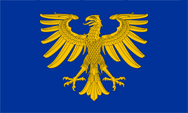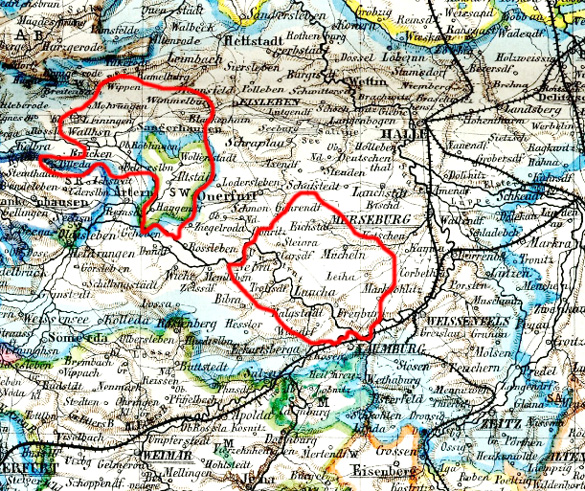mobile View, to the German Version tap the flag


- Palatinate County of Saxony (Sachsen, Saxe)
- former county of the German Empire
• Flag
• Meaning/Origin of the Flag
• Coat of Arms
• Meaning/Origin of the Coat of Arms
• Map
• History
• Origin of the Country's Name

10th cent. to 1815,
Escutcheon-flag of the Palatinate County of Saxony





The flags of the Middle Ages have been scutcheon-flags, what means that the image of the coat of arms was transferred to a flag.
Source: Volker Preuß


10th cent. to 1815,
Coat of arms of the Palatinate County of Saxony,
Source, by: Wikipedia (D)

The coat of arms of the Palatinate of Saxony shows the Imperial Eagle. The eagle was used frequently in coats of arms, because important representations of the nobility and imperial princes – as well as other important families – used the Imperial Eagle (black eagle on gold) in their arms or even took it over completely, however, the colours were often changed. The Palatinate of Saxony belonged in the years to very many noble families, so that the Saxon Eagle appeared in many coats of arms, as a "souvenir" or even as a sign of the claim to the territory or the title.
Source: Wikipedia (D),
Heraldique Europeenne


Source:
Brommes Illustrirter Hand-Atlas 1862, modyfied by: Volker Preuß
The map shows the Palatinate County of Saxony in about the year 1300, within a red border. The inside placed outline-colored areas got the Duchy of Saxony lost in 1680 to Saxony-Jena (orange) and in 1815 to Prussia (pale blue).

950 · the
German King Otto I. establishes in the southern part of the Duchy of Saxony, in the Saale-Unstrut-Rivers Region, the Palatinate County of Saxony for the management of royal estates in Grona, Werla, Wallhausen, Dornburg, Arnstadt, Sulza and also palaces and possessions in Magdeburg and Merseburg
1040 · Dedo Count of Goseck becomes Count Palatine
1088 · Friedrich of Sommerschenburg County Palatine of Putelendorf appropriates the Palatinate County of Saxony
1179 · Albert II. of Sommerschenburg dies, extinction of the family
1180 · in the conflict with the Staufen Emperor, Henry 'the Lion' gets outlawed, in the following struggles Henry 'the Lion' subjects and loses all possessions (even Bavaria), except Brunswick and Lueneburg, and some very small areas, Duke of Saxony becomes the Bernhard I. of Anhalt (Ascanian Dynasty), who actually speculated on the whole Duchy of Saxony, but he only received Eastphalia. Westphalia and Engern had been separated by the emperor, and the Palatinate County of Saxony was handed over to Ludwig 'The Pious', Ludwig III. the Landgrave of Thuringia (Ludowinger Dynasty)
1181 · Ludwig the Pious hands over the Palatinate County of Saxony to his brother Hermann
1217 · death of Hermann, successor is his son Ludwig
1227 · Ludwig dies on a crusade, his brother Heinrich Raspe takes over the Palatinate County, because the son of Ludwig, Hermann II., is still a minor
1241 · Hermann II. dies at the age of 19 years, Heinrich Raspe gets officially the Palatinate County of Saxony
1247 · death of Heinrich Raspe, extinction of the Ludowinger Dynasty, Heinrich, Margrave of Meissen from the House of Wettin (Heinrich the Illustrious), a nephew of Heinrich Raspe, becomes Count Palatine of Saxony
1288 · death of Heinrich the Illustrious, Count Palatine of Saxony becomes Heinrich I. Duke of Brunswick-Grubenhagen (Guelph Dynasty)
1291 · Heinrich I. sells the Palatinate County of Saxony, furthermore Landsberg, Delitzsch and Sangerhausen to the Margrave of Brandenburg (Ascanian Dynasty)
1318 · the Palatinate County of Saxony (only Lauchstaedt and Allstedt) comes as a dower and widow seat to Agnes, the widow of Heinrich the Elder of Brandenburg (Ascanian Dynasty)
1347 · the heirs of Agnes sell the Palatinate County of Saxony to the Margrave of Meissen, Frederick II. 'The Serious' (Wettin Dynasty)
1356 · Emperor Charles IV. passes the Golden Bull (a kind of constitution), the electoral dignity will be removed from Saxony-Lauenburg and remains with Saxony-Wittenberg (in the future so called Electorate of Saxony), but, with the Golden Bull, he declares the membership of the Palatinate County of Saxony to the Electorate of Saxony
1381 · Margrave Frederick IV., 'The Pugnacious', of Meissen (Wettin Dynasty) renounces the title of the Count Palatine, but preserves the golden eagle on a blue background in his coat of arms
1423 · King Sigismund awards on the basis of merits in the Hussite Wars, the Electorate of Saxony and the Palatinate County of Saxony to Friedrich IV., Margrave of Meissen (Wettin Dynasty), after in 1422 with the death of Albert III., the Ascanians extincted as electors and dukes of Saxony, Friedrich IV. calles itself Frederick I. as Elector
1485 · "Leipzig Partition" of the Wettin's estates between the brethren duke Albrecht (progenitor of the Wettin-Albertinians) and elector Ernst (progenitor of the Wettin-Ernestinians); Duke Albrecht: Land of Meissen, western Osterland, North Thuringia (incl. the territories of the Palatinate County of Saxony); Elector Ernst: Electorate of Saxony, South Thuringia, Vogtland
1547 · "Wittenberg Capitulation" the dignity of election passes from the Ernestinians to the Albertinians
11th of December in 1806 · "Peace of Posen" Napoléon I. compels Saxony to the joining into the Rhine Confederation, elevation of the elector to a king
16th–18th of October in 1813 · Battle of Nations near Leipzig, Napoléon I. is conquered, Saxony segregates from Napoléon I.
1814–1815 · Congress of Vienna, punishment of Saxony because of his loyalty to Napoléon I., it has to cede of territories to Prussia: Lower Lausitz, Upper Lausitz, Kur-District and Thuringian territories (including the areas of the Palatinate County of Saxony), Prussia established from some of these territories the Province of Saxony (incl. the territories of the former Palatinate County of Saxony)
Source: RetroBib Retrobibliothek,
Wikipedia (D),
Atlas zur Geschichte

The name "Palatinate of Saxony" refers with "Palatinate" to the origin of the country as an administrative center of imperial possessions, and with "Saxony" to its belonging of the Duchy of Saxony, as confirmed by the Golden Bull of 1356.
Source: Volker Preuß


![]()






